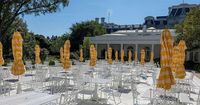On September 26, 2025, President Donald Trump unveiled the White House’s latest transformation: the gleaming new Palm Room, a lobby that now leads guests on a marble path directly to the famed Oval Office. With its brilliant white marble floor and dazzling chandeliers, the Palm Room marks just one in a series of bold—and, some say, controversial—renovations that have swept through 1600 Pennsylvania Avenue since Trump’s return to office.
Trump, never shy about his penchant for grandeur, took to social media to share his pride in the new addition. “New lobby leading to Oval Office — Magnificent marble floor, compliments of President Donald J. Trump!” he posted on Truth Social, as reported by Meaww. The Palm Room replaces what was once a more subdued, gray-tiled foyer, previously home to potted plants and benches. Now, visitors are greeted by a far more opulent scene: a marbled expanse, bright chandeliers overhead, and doors that open to the newly christened "Rose Garden Club at the White House."
But the Palm Room is hardly the only change. Over the past months, the Oval Office itself has been given a facelift, with golden accents now adorning the fireplace, doorways, and even the walls. According to The Hill, Trump also added a presidential seal to the ceiling above the Resolute Desk, explaining in a March interview that the room “needed a little life.” The president claimed he personally covered the cost of these shiny upgrades—an assertion the White House has backed up.
Trump’s flair for spectacle didn’t stop there. In June, he gifted two “magnificent poles made” to fly American flags on the North and South Lawns, declaring, “It is a GIFT from me of something which was always missing from this magnificent place.” These massive flagpoles, installed just in time for the summer, now tower over the manicured grounds, adding yet another personal touch to the executive mansion.
Perhaps the most headline-grabbing project, however, is the construction of a colossal new ballroom. Breaking ground earlier this month, the $200 million, 90,000-square-foot space is set to rise adjacent to the White House’s East Wing. The ballroom, which Trump has described as an “exquisite addition,” will host state dinners and major events, with a capacity of 900—up from the originally planned 650. “For 150 years they wanted a ballroom at the White House. We’re building something here at the highest level. Using great architects. It’s very exciting,” Trump said, as cited by The Hill.
The project, funded entirely through private donations, has already attracted pledges from companies and wealthy individuals, some offering $5 million or more. In exchange, their names will be permanently etched inside the White House—a detail that’s stirred both curiosity and concern. There’s talk of listing donors on a website, though a final decision has yet to be made. The expectation is that the ballroom will be completed before the end of Trump’s term in 2029.
While supporters hail these changes as visionary, critics have not held back. Senate Minority Leader Chuck Schumer, for instance, mocked the ballroom’s scale and cost in a Facebook video: “Maybe he can park his new plane in the new ballroom. It’s probably big enough.” Sen. Richard Blumenthal called the project a “gigantic boondoggle,” and Rep. Darren Soto quipped on X (formerly Twitter) that Trump would “dance blissfully” in the “fancy” ballroom built for him and his “rich buddies.” Soto’s critique went further, tying the renovations to broader concerns about the economy, tariffs, and mass deportations under Trump’s leadership.
Yet, defenders of the president’s approach point out that the White House has always evolved to reflect the tastes and priorities of its occupants. Stewart McLaurin, president of the White House Historical Association, told The Hill, “The history of the White House has evolved over 233 years since the cornerstone was laid in 1792. The South Portico, the North Portico, the East Wing, the West Wing, and the Truman Balcony all raised concerns at the time — but today, we can’t imagine the White House without these iconic elements.”
Trump’s renovation of the Rose Garden—now the “Rose Garden Club”—has been particularly emblematic of his personal style. The president ordered the lawn paved over, citing persistent sogginess that made it “soaking wet” and difficult for “the women with the high heels.” In his words, “The grass was not usable. Every time we’d have a press conference, women in particular were sinking deep into the mud, and at some point I said, you know, it’s time to make the change.” The new design features stone walkways and yellow and white-striped umbrellas reminiscent of Trump’s Mar-a-Lago resort, a detail highlighted by both Meaww and The Hill. A White House spokesperson went so far as to dub the club “the hottest place to be in Washington, or perhaps the world.”
Other recent additions include the “Presidential Walk of Fame,” a gallery of U.S. presidents’ portraits in golden frames along the West Wing Colonnade. Notably, where Joe Biden’s portrait would be, Trump installed a frame displaying only Biden’s autopen signature—a move that’s drawn its own share of commentary and speculation. Trump has also commissioned new artworks of himself for the White House, including a painting capturing the moment after last year’s attempted assassination in Pennsylvania, as reported by Meaww.
For some, these sweeping changes are simply part of a long tradition. Kate Andersen Brower, author of “The Residence: Inside the Private World of the White House,” told The Hill, “This is absolutely a builder’s dream, to be able to leave your mark on the country’s most famous house. This is about leaving his permanent stamp on the executive mansion. He wants people to remember his presidency. It will be hard to forget, but he’ll want people to remember what he did 100, 200, 300 years from now — and this is the way to do it.”
Of course, not all White House renovations have been so focused on aesthetics. The last major overhaul occurred in 1948 under President Harry Truman, when structural safety was at stake. “The Truman renovation was absolutely something that had to happen,” Brower explained. “In fact, when Margaret Truman was playing the piano on the second floor of the White House there were guests in the East Wing, and the piano almost fell through the ceiling. It was a dangerous thing to be in the White House at that time.”
Trump’s changes, by contrast, are largely about legacy, spectacle, and personal taste. Whether future generations will embrace the Palm Room’s marble shine, the ballroom’s grandeur, or the Rose Garden Club’s resort flair remains to be seen. For now, though, there’s no question that President Trump is determined to leave a mark on the White House that no one will soon forget.

